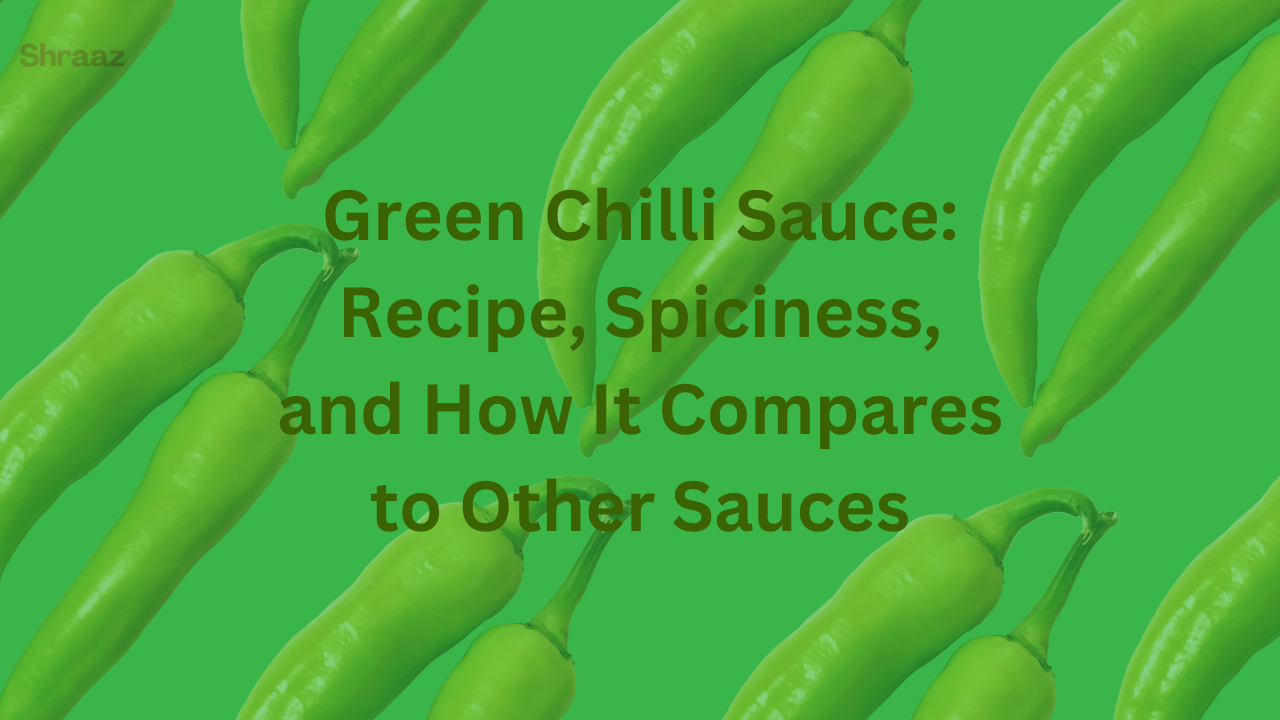What Are the Key Ingredients in Green Chilli Sauce?
Green chilli sauce is a popular condiment known for its spicy, tangy flavor, often used to elevate the taste of various dishes. While the ingredients can vary slightly depending on the recipe or regional influences, most green chilli sauces share some core components. Here, we’ll explore the key ingredients that go into making a delicious green chilli sauce.
1. Green Chillies
The star of the show in any green chilli sauce is, of course, the green chillies. These provide the spice and heat characteristic of the sauce. The type of green chilli used can impact the flavor and spice level. For example:
- Serrano: Medium heat, bright flavor.
- Jalapeño: Mild heat, slightly sweeter.
- Thai green chilli: Extremely spicy.
2. Garlic
Garlic is a crucial ingredient that adds depth and richness to the sauce. It balances the heat of the green chillies with its savory, pungent flavor. The amount of garlic used can vary depending on personal taste preferences.
3. Vinegar
Vinegar provides the acidic kick that gives green chilli sauce its signature tang. It helps balance the heat from the chillies and ensures the sauce has a long shelf life by acting as a preservative. Common types of vinegar used include:
- White vinegar: For a sharp, clean taste.
- Apple cider vinegar: Adds a fruity, slightly sweet flavor.
4. Salt
Salt enhances the overall flavor of the green chilli sauce. It brings out the spice, sweetness, and tanginess of the other ingredients. It also acts as a preservative in some cases, especially in homemade sauces.
5. Sugar
Though not always included, sugar is often added to green chilli sauce to balance the heat and tang. It can round out the flavor profile, making the sauce more palatable to those sensitive to spiciness. Sugar can also help to highlight the natural sweetness of the chillies.
6. Lime Juice
Lime juice is another acidic element that complements vinegar in green chilli sauce. Its fresh, citrusy flavor adds brightness and enhances the overall taste of the sauce. Lime juice is particularly common in Mexican and Southeast Asian versions of green chilli sauce.
7. Cilantro (Coriander Leaves)
For a fresh, herby flavor, cilantro is sometimes added to green chilli sauce. It pairs well with the heat of the chillies and the acidity of the lime juice. Cilantro also gives the sauce a vibrant green color.
8. Oil
Oil, such as olive or vegetable oil, is often used to blend the ingredients smoothly and give the sauce a rich, glossy texture. It also helps to distribute the flavor evenly throughout the sauce.
9. Water
Water may be added to adjust the consistency of the sauce. A thinner sauce might be desirable for drizzling, while a thicker consistency could be better for dipping or marinating.
10. Optional Ingredients
Depending on the recipe or regional variation, several optional ingredients can be added to customize the flavor of green chilli sauce:
- Ginger: Adds warmth and depth.
- Cumin: Provides an earthy, smoky flavor.
- Mint: Adds freshness, particularly in Indian green chilli sauces.
- Tomatillos: Used in some Mexican versions, adding a slightly tart flavor.
| Ingredient | Function |
| Green Chillies | Heat and spice |
| Garlic | Depth and richness |
| Vinegar | Tang and preservative |
| Salt | Flavor enhancement |
| Sugar | Balances heat and acidity |
| Lime Juice | Fresh citrus flavor |
| Cilantro | Herbaceous freshness |
| Oil | Blending and texture |
| Water | Adjusts consistency |
| Optional Spices | Customizes flavor (e.g., ginger, cumin, mint) |
These core ingredients form the basis of a versatile green chilli sauce that can be customized to suit various dishes and taste preferences.
How Do You Make Green Chilli Sauce at Home?
Making green chilli sauce at home is a simple process that allows you to customize the flavor and spice level to your liking. By using fresh ingredients, you can create a vibrant and delicious sauce that’s free from preservatives and additives. Below is a step-by-step guide on how to make your own green chilli sauce.
1. Ingredients You’ll Need
To get started, gather the following ingredients:
- 10-12 fresh green chillies (Jalapeño, Serrano, or Thai green chillies)
- 5-6 garlic cloves
- 1/4 cup vinegar (white or apple cider)
- 1/2 tsp salt
- 1 tbsp sugar (optional)
- 2 tbsp lime juice
- 1/4 cup cilantro (optional)
- 1 tbsp oil (olive or vegetable)
- 1/2 cup water
2. Prepare the Chillies
Begin by washing the green chillies thoroughly. If you want to reduce the spiciness, you can remove the seeds from the chillies. Otherwise, you can leave them intact for extra heat. Chop the chillies into small pieces to make them easier to blend.
3. Blend the Ingredients
In a blender or food processor, add the chopped green chillies, garlic cloves, vinegar, salt, sugar (if using), lime juice, and cilantro. Blend until the ingredients form a smooth paste. You can adjust the consistency by adding a bit of water as needed.
4. Adjust Seasoning
Taste the sauce and adjust the seasoning as necessary. If it’s too spicy, you can add a bit more sugar or lime juice to balance the heat. If it’s too sour, reduce the amount of vinegar.
5. Simmer the Sauce
Pour the blended mixture into a saucepan and simmer it on low heat for about 10-15 minutes. This helps to blend the flavors and slightly reduce the acidity from the vinegar. Stir occasionally to prevent sticking.
6. Add Oil for Texture
As the sauce simmers, add the oil and continue stirring. The oil gives the sauce a smooth and glossy texture, making it easier to spread or drizzle over dishes.
7. Let It Cool
Once the sauce has simmered to your desired consistency, remove it from the heat and allow it to cool. Cooling the sauce helps the flavors develop further.
8. Strain (Optional)
If you prefer a smoother sauce, you can strain the mixture through a fine-mesh sieve to remove any remaining chunks of garlic or chillies. This step is optional, as some people prefer a chunkier texture.
9. Store Properly
Transfer the cooled sauce into an airtight container or glass jar. Homemade green chilli sauce can be stored in the refrigerator for up to 2 weeks. If you’ve added a good amount of vinegar and salt, the sauce may last longer.
10. Enjoy Your Homemade Green Chilli Sauce
You can now enjoy your homemade green chilli sauce on a variety of dishes, from grilled meats and vegetables to sandwiches and tacos.
| Step | Action |
| 1. Gather Ingredients | Assemble all necessary ingredients. |
| 2. Prepare Chillies | Chop and deseed if desired. |
| 3. Blend Ingredients | Blend all the components into a paste. |
| 4. Adjust Seasoning | Taste and tweak seasoning as needed. |
| 5. Simmer Sauce | Cook the mixture on low heat. |
| 6. Add Oil | Stir in oil for texture. |
| 7. Cool the Sauce | Allow the mixture to cool. |
| 8. Strain (Optional) | Strain for a smoother consistency. |
| 9. Store Properly | Keep in an airtight container. |
| 10. Enjoy! | Use the sauce as desired in meals. |
Homemade green chilli sauce is an easy, flavorful addition to your kitchen that you can modify to suit your taste.
What Is the Difference Between Green Chilli Sauce and Red Chilli Sauce?
Green chilli sauce and red chilli sauce are both popular condiments known for their spicy, tangy flavors, but they differ in a few key ways. These differences arise primarily due to the type of chillies used, flavor profiles, and culinary applications. In this article, we will explore the distinctions between these two types of chilli sauces in detail.
1. Color and Appearance
The most obvious difference between green and red chilli sauces is their color:
- Green chilli sauce is made from fresh green chillies, giving it a vibrant green color.
- Red chilli sauce is made from ripe red chillies, resulting in a bold red hue.
These visual differences can also influence the perceived flavor and intensity of the sauces.
2. Heat Level
The heat level between green and red chilli sauces can vary significantly depending on the type of chillies used:
- Green chilli sauce tends to have a fresher, brighter heat, which can range from mild to very spicy. Green chillies, like jalapeños or serranos, are often milder compared to their red counterparts.
- Red chilli sauce typically has a deeper, more intense heat. This is because red chillies, such as cayenne or red Thai chillies, tend to be spicier due to their ripeness and the concentration of capsaicin.
| Sauce Type | Heat Level |
| Green Chilli Sauce | Bright, fresh, can range from mild to spicy |
| Red Chilli Sauce | Deep, intense heat, often spicier |
3. Flavor Profile
The flavor profiles of these sauces differ due to the ripeness of the chillies:
- Green chilli sauce has a more herbaceous, tangy flavor, with hints of freshness and sharpness. This is due to the use of unripe green chillies, which have a grassy, vibrant taste.
- Red chilli sauce offers a sweeter, earthier flavor. As the chillies ripen, they develop a natural sweetness that complements their heat, giving the sauce a rich and smoky taste.
4. Ingredients
While the core ingredients like garlic, vinegar, and salt are often the same, the difference lies in the main chilli used:
- Green chilli sauce is made with fresh green chillies and often includes ingredients like lime juice and cilantro to enhance the fresh, zesty flavor.
- Red chilli sauce uses ripe red chillies, which are sometimes dried and rehydrated for more complex flavors. It may also contain tomatoes or roasted peppers to deepen the taste.
5. Texture
Both sauces can have varying textures depending on the recipe, but there are general differences:
- Green chilli sauce tends to be thinner and more watery, as it is often used as a fresh condiment or drizzling sauce.
- Red chilli sauce is typically thicker, especially if made with roasted or dried chillies, and is used more as a dipping sauce or glaze.
6. Culinary Uses
Green and red chilli sauces have distinct culinary applications:
- Green chilli sauce is popular in Mexican, Thai, and Indian cuisines, where it is used to add brightness and spice to tacos, curries, or stir-fries.
- Red chilli sauce is commonly found in Chinese, Korean, and American cuisines, where it is used to add deep heat to dishes like stir-fried noodles, grilled meats, or as a base for spicy soups.
| Sauce Type | Common Uses |
| Green Chilli Sauce | Tacos, stir-fries, curries |
| Red Chilli Sauce | Noodles, grilled meats, spicy soups |
7. Shelf Life
The shelf life of these sauces can vary slightly:
- Green chilli sauce is made with fresh ingredients, which can reduce its shelf life. Homemade versions last about 1-2 weeks in the refrigerator.
- Red chilli sauce may last longer, especially if made with dried or roasted chillies. Its shelf life is typically 2-4 weeks in the refrigerator.
8. Regional Variations
Both sauces have regional variations that influence their flavor and heat:
- Green chilli sauce is often associated with Mexican salsa verde, Thai green curry paste, and Indian coriander chutney.
- Red chilli sauce appears in many Chinese dishes, such as Szechuan sauces, Korean gochujang, and American buffalo sauce.
9. Nutritional Value
In terms of nutritional value, both sauces offer similar benefits:
- Both sauces are low in calories but rich in vitamins A and C due to the chilli peppers.
- Green chillies tend to have slightly more vitamin C, while red chillies are richer in vitamin A due to their ripeness.
10. Conclusion: Which One to Choose?
Choosing between green and red chilli sauce depends on your taste preferences and the dish you are preparing:
- If you want a fresh, tangy heat, green chilli sauce is ideal.
- If you prefer a deep, smoky, and intense heat, go for red chilli sauce.
Both sauces bring their unique characteristics to the table, making them versatile condiments for a variety of cuisines.
How Spicy Is Green Chilli Sauce Compared to Other Sauces?
The spiciness of green chilli sauce can range significantly, depending on the type of chillies used and how the sauce is prepared. The Scoville Heat Units (SHU) scale measures the heat of chillies, with green chilli sauce generally falling in the middle of the spectrum.
- Scoville Heat Scale
The SHU scale is a measure of spiciness, with bell peppers at 0 SHU and Carolina Reapers exceeding 2 million SHU. Green chillies such as jalapeños or serranos, often used in green chilli sauce, range between 2,500 to 23,000 SHU, giving the sauce a medium level of heat. - Types of Green Chillies Used
Green chilli sauces can be made from a variety of chillies, such as:- Jalapeños (2,500-8,000 SHU): Mild heat, often used in Mexican green sauces.
- Serrano (10,000-23,000 SHU): Medium to high heat, common in spicier versions.
- Thai Green Chillies (50,000-100,000 SHU): Extremely hot, used in Southeast Asian sauces.
- Green Chilli Sauce vs. Red Chilli Sauce
Red chilli sauce tends to be spicier than green chilli sauce because red chillies contain more capsaicin. Red sauces, such as Sriracha (2,500 SHU) and cayenne-based sauces (30,000-50,000 SHU), often deliver a deeper heat than the fresh, sharp burn of green chilli sauce. - Comparing with Other Hot Sauces
Compared to popular hot sauces like Tabasco (2,500-5,000 SHU) or Frank’s RedHot (450 SHU), green chilli sauces can be similarly mild or even spicier depending on the chilli variety. - Green Chilli Sauce for Beginners
For those new to spice, green chilli sauces made from mild jalapeños provide a manageable heat. For those seeking a more intense experience, sauces with serrano or Thai chillies will deliver an extra kick.
| Sauce Type | Scoville Heat Units (SHU) |
| Green Chilli Sauce | 2,500 – 100,000 (depending on chilli type) |
| Sriracha | 1,000 – 2,500 |
| Tabasco | 2,500 – 5,000 |
| Habanero Sauce | 100,000 – 350,000 |
Controlling the Heat in Homemade Sauce
If you’re making green chilli sauce at home, you can adjust the heat by removing the seeds and membranes of the chillies, where most of the capsaicin resides. Keeping these parts increases the spiciness.- Green Chilli Sauce in Different Cuisines
The spiciness of green chilli sauce varies by region. In Thai cuisine, the sauce tends to be fiery hot, while in Mexican and Indian dishes, it is more moderate in spice, providing heat along with tangy flavor notes. - Serving Suggestions Based on Heat
Spicier green chilli sauces pair well with rich, creamy dishes like guacamole or curries, while milder versions can be drizzled over grilled vegetables or used as a topping for tacos. - Spice Tolerance Levels
Everyone’s tolerance to spice varies. If you’re not accustomed to heat, start with small amounts of green chilli sauce and gradually increase the portion as you become more comfortable. - Conclusion on Spiciness
In summary, green chilli sauce can be as mild or as hot as you desire, depending on the type of chillies used and your preparation methods. It offers a fresh, sometimes zesty heat that is distinct from the deeper, smokier flavors of red chilli sauces.
What Are the Best Uses for Green Chilli Sauce in Cooking?
Green chilli sauce’s bright, zesty heat makes it a favorite ingredient in many dishes. Its versatility allows it to complement a wide variety of flavors, from grilled meats to vegetarian recipes. Here are some of the best culinary uses for green chilli sauce.
- Dipping Sauce
One of the most common uses of green chilli sauce is as a dipping sauce for appetizers. It pairs well with:- Spring rolls or dumplings in Asian cuisine.
- Samosas or pakoras in Indian cuisine.
- Tortilla chips in Mexican cuisine.
- Taco Topping
A spoonful of green chilli sauce adds a zesty kick to any taco. Its tangy heat balances out rich fillings like grilled chicken, beef, or pork, as well as lighter options like fish tacos. - Marinades
Green chilli sauce works as an excellent marinade for meats and vegetables:- Combine it with olive oil, garlic, and lime juice for a grilled chicken marinade.
- Use it as a base for vegetable kabobs to add a pop of heat and freshness.
- In Soups and Stews
Stir a few spoonfuls of green chilli sauce into soups or stews to elevate the flavor. It works particularly well in brothy soups like pho or hearty vegetable stews. - Curry Enhancer
Green chilli sauce can be used to enhance the heat in curries, particularly those with a coconut milk base, such as Thai green curry. The brightness of the sauce balances the creaminess of the coconut. - Pizza Topping
Add a drizzle of green chilli sauce over pizza for a spicy alternative to traditional red pepper flakes. It pairs particularly well with pizzas topped with feta, olives, or roasted vegetables. - Egg Dishes
Green chilli sauce is a fantastic addition to breakfast dishes:- Drizzle it over scrambled eggs for a spicy morning kick.
- Add it to an omelet filled with cheese and veggies for extra flavor.
- Grilled or Roasted Vegetables
Toss roasted or grilled vegetables in green chilli sauce to add tang and heat to simple side dishes. Zucchini, bell peppers, and carrots are particularly good candidates. - Burgers and Sandwiches
Swap out traditional condiments like ketchup or mayonnaise for green chilli sauce on burgers or sandwiches to add a spicy twist. - Pasta Sauces
While it might not be the most traditional use, green chilli sauce can be stirred into pasta sauces for a zesty, spicy flavor, particularly in creamy Alfredo or pesto-based dishes.
Is Green Chilli Sauce Healthy?
Green chilli sauce, aside from its bold flavor, can also offer some surprising health benefits. Made primarily from chillies, garlic, vinegar, and sometimes herbs, this condiment is low in calories but packed with vitamins, antioxidants, and metabolism-boosting compounds.
- Low in Calories
Green chilli sauce is very low in calories, often containing less than 10 calories per serving. This makes it a great addition for anyone looking to add flavor to their meals without extra fat or calories. - Rich in Vitamins A and C
Chillies, particularly green chillies, are an excellent source of vitamins A and C. These vitamins are important for immune function, vision, and skin health. Regular consumption of green chilli sauce can contribute to your daily vitamin intake. - Boosts Metabolism
Capsaicin, the compound responsible for the heat in chillies, is known to boost metabolism by increasing the body’s ability to burn fat. Adding green chilli sauce to your diet could aid in weight management efforts. - Anti-Inflammatory Properties
Capsaicin also has anti-inflammatory properties. Regular consumption of green chilli sauce may help reduce inflammation in the body, which is linked to various chronic diseases such as arthritis. - High in Antioxidants
Chillies are loaded with antioxidants that protect the body from free radical damage. These antioxidants may reduce the risk of cancer and heart disease. - Improves Digestion
Green chilli sauce can stimulate digestive enzymes and promote better digestion. Its combination of acidity (from vinegar or lime juice) and spice can aid in breaking down food, making it easier to digest. - Promotes Heart Health
Some studies have shown that the capsaicin in chillies can help lower blood pressure and reduce cholesterol levels, promoting overall heart health. - Natural Pain Relief
Capsaicin is also used in topical treatments for pain relief. Although you wouldn’t apply green chilli sauce to your skin, the compound itself can reduce pain when consumed, as it triggers the brain to release endorphins, which act as natural painkillers. - Low in Sugar
Many store-bought sauces are loaded with sugar, but green chilli sauce tends to be very low in sugar or completely sugar-free. This makes it a healthier option compared to other bottled sauces. - Potential Drawbacks
Despite its health benefits, it’s worth noting that consuming too much spicy food can irritate the stomach lining in some people, leading to discomfort. Moderation is key when enjoying green chilli sauce.
How Long Can You Store Homemade Green Chilli Sauce?
Homemade green chilli sauce is a delicious and fresh alternative to store-bought versions, but it’s essential to store it properly to maximize its shelf life. With the right care, homemade green chilli sauce can last anywhere from a few weeks to several months.
- Refrigeration is Key
Once you’ve made your green chilli sauce, it should be stored in an airtight container in the refrigerator. The cold temperature slows the growth of bacteria and helps preserve the sauce for up to 2-4 weeks. - Vinegar Content Affects Longevity
The more vinegar or acidic ingredients in the sauce, the longer it will last. Vinegar acts as a natural preservative, preventing the growth of bacteria. If your recipe includes a high amount of vinegar, your green chilli sauce could last up to 6 months in the refrigerator. - Freezing for Long-Term Storage
If you’ve made a large batch of green chilli sauce and don’t think you’ll finish it within a month, you can freeze it. Pour the sauce into an ice cube tray, freeze it, and transfer the cubes to a freezer-safe bag. This method allows you to defrost small portions as needed. - Sterilized Jars for Preservation
Another way to extend the shelf life of homemade green chilli sauce is to store it in sterilized glass jars. The sterilization process eliminates bacteria that could spoil the sauce, allowing it to last longer. - Signs of Spoilage
Always check for signs of spoilage before using older green chilli sauce. If the sauce develops an off smell, mold, or a change in texture, it’s time to discard it. - How to Sterilize Jars
To sterilize jars, simply boil them in water for 10-15 minutes and let them air dry. Pour your freshly made green chilli sauce into the sterilized jars while the sauce is still hot, then seal immediately to create a vacuum. - Factors That Shorten Shelf Life
Adding fresh ingredients like coriander or cilantro to your green chilli sauce can shorten its shelf life. These herbs tend to spoil faster than vinegar-based sauces, so use them sparingly or consume the sauce quickly. - Canning as a Preservation Method
If you’re familiar with the process of canning, you can store homemade green chilli sauce for even longer periods—up to a year. Canning involves heating the sauce in jars to destroy bacteria and sealing them in a vacuum environment. - Refrigeration Time for Opened Store-Bought Sauces
Store-bought green chilli sauces that contain preservatives can last much longer—often up to a year when unopened. However, once opened, they should be kept in the fridge and consumed within a few months. - Preservation Table for Homemade Green Chilli Sauce
| Storage Method | Estimated Shelf Life |
| Refrigeration (Airtight) | 2-4 weeks |
| Vinegar-Based (Refrigeration) | 3-6 months |
| Freezing | 6-12 months |
| Sterilized Jars (Refrigeration) | 3-6 months |
| Canned (Unopened) | Up to 1 year |
What Are the Variations of Green Chilli Sauce Across Different Cultures?
Green chilli sauce has many cultural variations, reflecting the diversity of the regions that embrace this spicy condiment. Each version has its unique twist, from the choice of chillies to added ingredients and the specific dishes they complement.
- Mexican Green Chilli Sauce (Salsa Verde)
Salsa verde is one of the most popular green chilli sauces in Mexico, made with roasted tomatillos, jalapeños, onions, and garlic. It has a tangy, fresh flavor and is commonly served with tacos, enchiladas, or grilled meats. - Indian Green Chilli Sauce
In India, green chilli sauce is often made with green chillies, coriander leaves, garlic, and lemon juice. It’s a staple condiment for street food such as samosas, pakoras, and chaat. Indian green chilli sauce tends to have a balanced heat, with plenty of fresh, herbal flavors. - Thai Green Chilli Sauce (Nam Prik Noom)
Nam Prik Noom is a fiery green chilli sauce from Northern Thailand, made with roasted green chillies, garlic, and shallots. It has an intense, smoky heat and is typically served with sticky rice or grilled meats. - Chinese Green Chilli Sauce
In Chinese cuisine, green chilli sauce is often fermented and used as a condiment for dumplings or noodles. It’s usually made with green chillies, garlic, vinegar, and a touch of sugar for balance. - Middle Eastern Zhug
Zhug is a Yemeni green chilli sauce that has spread across the Middle East. Made with hot green chillies, cilantro, garlic, and various spices like cumin and cardamom, zhug is used as a condiment for falafel, shawarma, and grilled meats. - Peruvian Aji Verde
Aji verde is a Peruvian green chilli sauce that blends green chillies with herbs, lime juice, and often mayonnaise or cheese to create a creamy, tangy sauce. It’s served with roasted chicken, fries, and various Peruvian dishes. - Caribbean Green Chilli Sauce
In the Caribbean, green chilli sauce is made with Scotch bonnet peppers, known for their intense heat, along with vinegar and local spices. This sauce is extremely hot and used sparingly in dishes like jerk chicken. - Green Harissa
In North African cuisine, green harissa is a version of the traditional red harissa, made with green chillies, garlic, and cumin. It has a smoky, spicy flavor and is used to flavor couscous, tagines, and grilled meats. - Argentinian Chimichurri
Though not traditionally referred to as green chilli sauce, chimichurri from Argentina contains chopped green chillies along with parsley, garlic, vinegar, and olive oil. It’s a tangy, herbaceous sauce served with grilled meats. - Fusion Variations
With the global popularity of green chilli sauce, many fusion variations have emerged. Chefs around the world are experimenting with new ingredients and combinations, such as green chilli and avocado sauce or green chilli sriracha.




